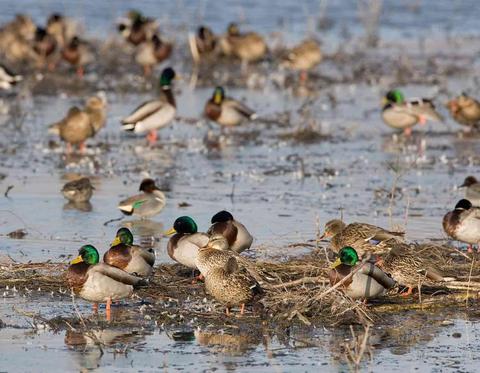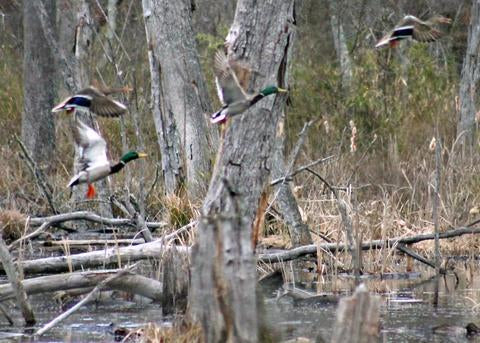
Waterfowl Hunting: Basics For Hunting Early-Season Mallards
Waterfowl Hunting: Basics For Hunting Early-Season Mallards
Mallards are one of the most sought-after species of ducks but waterfowl hunting enthusiasts. Waterfowl hunters from all over will go to great lengths to get a drake mallard. I bet if you polled every duck hunter in the United States it would be greater than 90 percent the favorite species targeted. Mallards are a large species of duck that features a drake with a green head. It is because of this that they get the nickname "greenheads". As mentioned before they are larger than most species of waterfowl and can tip the scale at 3lbs per duck. The smaller hens, female mallards, are a brown color with a beautiful blue identification mark. This mark is shared by both the drakes and the hens.

Mallards In Wet Lands (Photo Credit: MDC Discover Nature)
One reason many waterfowl hunters love to target mallards is that they are found in all four flyways. They are one of the most distributed waterfowl species in North America. They are a tough bird that can handle the elements that mother nature throws at it. They will remain as far north as possible as long as they can find open water. They need the open water on ponds to feed. As soon as these water sources freeze, the greenheads will move south.
Where To Find Early Season Mallards

Flying Mallards Near Beaver Pond (Photo Credit: Elliott Recreational Properties)
In many areas, you will often find locally raised birds. These are the mallards that know the area and have an abundance of food supply nearby. One thing you must remember as a waterfowl hunter is the more extreme the temperatures and elements, the more food consumption a duck must consume to survive. If you find the feed, you will find the mallards. Early in the duck hunting season are usually mild temperatures. Mallards do not have to eat like its sub-zero conditions. There are several areas that are usually good to check for local greenheads. These areas are farm ponds, large freshwater marshes, slow-water creeks, and any flooded rice fields. These mallards will not be in large flocks. Target small flocks of ducks hiding on unfamiliar water. If you are on the coast this could be salt marshes, if you are more inland look for pasture ponds, shallow water lakes, beaver pools, and backwater bays.
Decoy Spread For Early Season Mallards

Mallard Decoy Spread (Photo Credit: Dakota Decoys)
When it comes to early season mallards, location is key. Finding the right location will guarantee a successful hunt rather than having an elaborate decoy spread. Many of the early season mallards will be young birds. You will find your success with a decoy spread that consists of floating decoys, spinner decoys, and electric swimming decoys. Early season success will be better with there younger birds. The more they are hunted the smarter they become. The mallard decoy spread should consist of just the minimum. A dozen mallard floating decoys with the majority being hens will usually be enough for these early season mallards. It is always good to add a few Canadian geese floaters or some green-winged teal to add a layer to the spread. This will allow for the mallards to get a sense of security of the area while flying by and also be more visible to them at farther distances. When it comes to any spread, the movement is key. By adding movement will give your duck spread the life needed to bring in greenheads flying overhead. Add movement with a jerk string or water motion decoys.
How To Call Early Season Mallards

Calling In Mallards (Photo Credit:Prairewind Decoys)
One of the best ways for bringing in mallards to a spread is by calling. Mallard sounds will always attract mallard that is nearby. Early season you will encounter a lot of unresponsive birds to calling. In this scenario, it is good to throw some mallard quacks at passing birds. Having the right call for the job can be important for getting the right calls that could ultimately bring in the ducks. Several of my favorite calls come from the Hobo Duck Calls collection. Depending on the areas you are hunting the type and volume of the call is very important. Remember new birds respond better to calling than stale birds. However, every day is different and you have to see whats working that day. Calling can consist of anything from screaming at them to not making a sound.
The Gear For Early Season Mallards

Old School Trucker Mallard From ECW (Photo Credit:@3li.leonard)
When it comes to hunting early season mallards it is important to have the right gear. Since the temperatures will be milder then later in the season you can hold off on the heavy weather clothing. Having a great pair of waders will be money well spent. As far as shells, early season mallards will have a lighter coat during this time. A 2 3⁄4-inch 12-gauge hull packing 11⁄8 ounce of Hevi-Metal No. 4s at 1500 fps is perfect for early season ducks. If you know you will be hunting geese as well then use 3-inch loads throwing 11⁄4 ounces of Hevi-Metal No. 2s. These will be sufficient for targeting mallards or geese. The last thing you need is a duck hunting hat. Having the right trucker hat for pictures afterward is important for your social media statues. The Old School Camo Mallard Trucker Snap Back from East Coast Waterfowl or the Mallard Wing Snapback from Fowl are two hats guaranteed to make your friends ask where you got them from.
One of the best times of the year is when duck season starts up again. Getting out there and trying your luck at some early season mallards can be rewarding if you know what you are doing. If you have any questions, comments or concerns, please feel free to leave us a comment below or email us at info@HFDepot.com. We would love to hear about your early season hunting trip experiences. We would also love to see all of your duck hunting kills so make sure you send us all your great duck photos to be featured on our social media pages. So get out there and start waterfowl hunting for early season mallards.


Leave a comment